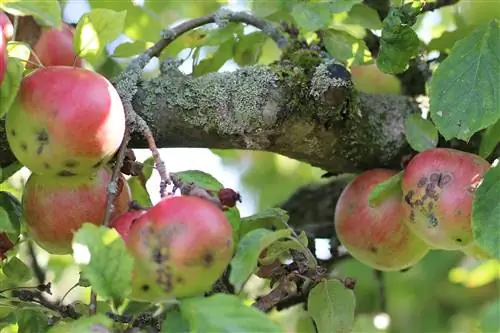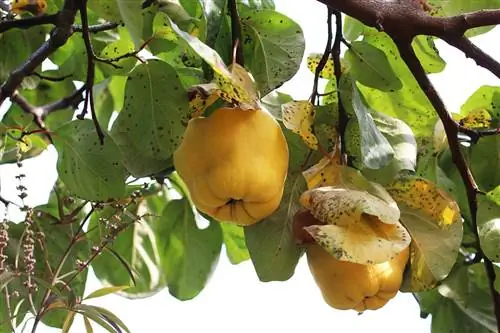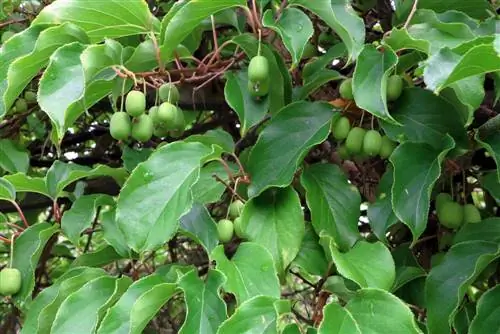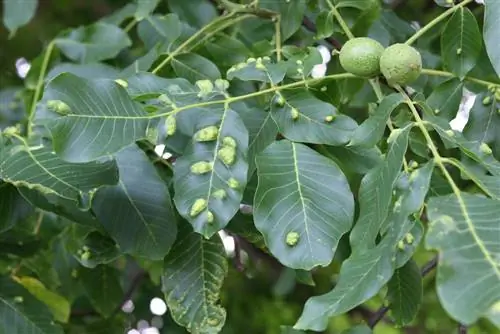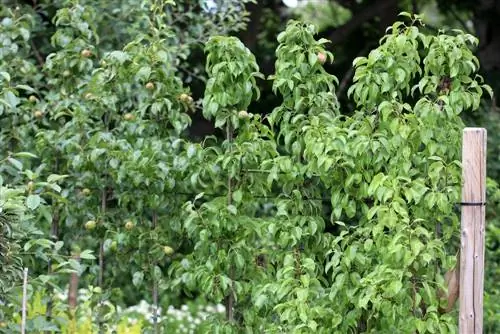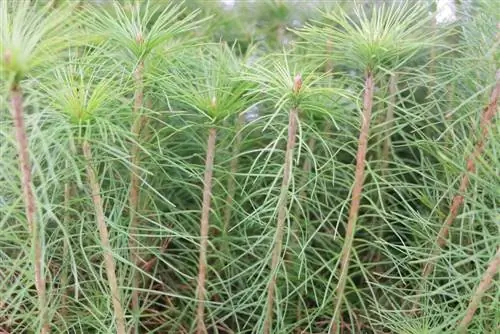- Author admin [email protected].
- Public 2023-12-17 03:39.
- Last modified 2025-01-24 12:45.
Pests and diseases on fruit trees can not only damage the crop yield. We show which problems can occur, how to recognize them and combat them successfully.
Roots
Root head, Mauke
Symptoms
This disease, caused by soil bacteria, causes gall-like growths on the roots and root collar, and more rarely at the base of the trunk.
Note:
The pathogen penetrates through injuries.
Initially the growths are soft and smooth, later they become dark brown and woody. They can grow more than the size of a fist. Young trees in particular are severely stunted in their growth, but often recover as they get older. The disease on the grape vine is known as mudworm. Here the growths occur primarily at the grafting site and also severely affect the growth and yield of older plants.
Infected plants
All types of fruit, especially apples, pears, raspberries, cherries and plums as well as wine.
Combat
Thoroughly amend heavy, wet soils before planting fruit trees. In grafted plants, the disease can be prevented by choosing rootstocks that are less susceptible. If the plants are in severe distress, it is better to remove them than to hope for recovery, but do not plant new trees in the same place.
Trunks and branches
galena disease
Symptoms
Leaf-like, brown-violet mushroom fruiting bodies grow in the lower part of the trunk. What is initially more noticeable are the leaves, which turn silvery to lead-gray as soon as they sprout. Fruits usually fall off completely because the flowers have already withered away. The wood fungus infects trunks and branches through wounds and can destroy the entire tree. In addition to all types of tree fruit, it also attacks soft fruit.
Infected plants
Especially apples and pears
Combat
Take preventative measures to avoid bark injuries, for example: also by using a white coat of paint to prevent frost cracks. Always cleanly trim frayed cuts, apply wound closure agent to all larger wounds, and do not leave any unnecessary stubs. Cut out affected areas generously down to the he althy wood, smooth the cut edges with a smooth knife, and treat the interface with a wound closure agent. Do not put infected parts in the compost.
Blood lice
Symptoms
White, cotton-like deposits appear on trunks and shoots, under which reddish-brown lice, approximately 2 mm in size, can sometimes be seen. Cancerous growths form on the bark, which later tear open like knots. New shoots above such places do not mature properly. This damage is caused by blood lice, which suck plant sap from young shoots or through cracks in the bark. The pests can reproduce asexually; one louse can have over 100 offspring, which then overwinter in protected areas of the tree bark. Warm, humid weather encourages blood lice to multiply.
Infected plants
Apple
Combat
Pay attention to apple varieties and rootstocks that are less susceptible. Encourage beneficial insects such as ladybugs, earwigs, hoverflies and birds that consume the bloodlice. Spray off the woolly white coating with a sharp jet of water and, if the infestation is severe, use insecticides that are gentle on beneficial insects. Carefully cut out the growths and treat the areas with a wound closure agent. In winter, clean the trunk with a wire brush or tree scraper to remove the lice from their hiding places in the bark.
rubber river
Symptoms
Light or brownish, viscous drops appear on trunks and shoots and harden into rubbery lumps. It is a physiological disorder in response to various negative environmental influences. The young wood is “liquefied” to a certain extent. This can cause entire sections of branches to die. The trigger for the rubber flow is usually injuries to the bark.
Infected plants
Stone fruit trees, especially cherries and peaches.
Combat
Trees on heavy, moist or waterlogged soils and in places exposed to frost are particularly at risk. A suitable choice of location and thorough soil cultivation or, if necessary, soil improvement are therefore among the most important precautions. Balanced, nitrogen-reduced fertilization also reduces the risk. Also avoid unnecessary damage to the bark. Larger cuts are best only carried out in the summer when the wounds heal more quickly. Apply a wound closure agent to all slightly larger cut surfaces. When pruning endangered trees, you first cut short stubs, unlike usual. If necessary, they are sacrificed to the rubber flow and then only removed directly at the branching point the following year. Otherwise, cut out areas of rubber flow deep into the he althy wood and treat the interface carefully with wound closure agent.
Fruit tree cancer
Symptoms
Initially, affected areas of the bark change color rather inconspicuously and you can see sunken spots. Then the bark tears open, red spore deposits and finally cancerous growths form, over time surrounded by ring-like bulges. Fruit is often affected and later rots in storage. Individual branches or the entire tree can die completely. The harmful fungus occurs particularly in rainy areas. It penetrates the wood through cuts, branch stubs, frost cracks and other bark injuries.
Infected plants
Especially apples and pears.
Combat
Take preventive measures to avoid bark injuries, for example by using a white coat of paint to prevent frost cracks. Always cleanly trim frayed cuts, apply wound closure agent to all larger wounds, and do not leave any unnecessary stubs. Cut out affected areas generously down to the he althy wood, smooth the cut edges with a sharp knife, and treat the cut area with a wound closure agent. Do not put infected parts in the compost.
leaves
Pear grid
Symptoms
From early summer onwards, conspicuous orange-red spots appear on the tops of the leaves and enlarge. Over the course of the summer, the bulbous, yellow-brown spore deposits of the fungus with grid-like openings form on the undersides of the leaves.
Infected plants
Pear
Combat
The most important precaution is not to plant Sade tree or other types of juniper at least 200 m away from pear trees. The harmful fungus overwinters on these coniferous trees and then moves to the pears in the spring via wind or rain. If shoots on juniper plants in your garden noticeably swell in spring and bear gelatinous, orange-yellow structures, remove these branches immediately; they contain the new fungal spores. Otherwise, removing infected pear leaves early is usually enough to prevent noticeable damage. Fungicides against pear scab sometimes also have a side effect against pear scab.
Aphids
Symptoms
Various green, black, gray or brown aphids appear on fruit trees. Despite its name, the green peach aphid can attack almost all fruit trees, while apple aphids, for example, which are also green or mealy gray, only feed on apple trees. However, the damage that aphids cause is similar to all plants: the leaves curl and curl up, turn yellow and ultimately fall off, the shoot tips or even the flowers and fruits are deformed. The pests usually reside in dense colonies on young shoot tips or undersides of leaves. The leaves are often covered in sticky honeydew, on which blackish sooty mold fungi settle.
Note:
Lice are particularly dangerous due to the transmission of pathogenic viruses.
Infected plants
Almost all fruit plants
Combat
Encourage natural enemies of aphids, such as lacewings, ladybirds and earwigs. Only use pesticides that are gentle on beneficial insects. Place rings of glue around the trunks so that the aphid-supporting ants cannot crawl up. Spray the lice off again and again with a strong jet of water, or simply wipe them off in easily accessible areas with a paper tissue. It is best to cut out very badly infected shoots. Nettle extracts have proven to be effective as homemade sprays.
phylloxera
Symptoms
Red galls, which house the eggs and yellowish larvae, form on the undersides of the leaves, and light-colored nodules appear on the roots. The vine takes care of and can die completely.
Infected plants
Grapevine
Combat
Only plant grafted vines that have been grafted onto phylloxera-resistant rootstocks. For example, if you suspect an infestation on a vine you have propagated yourself, notify the local plant protection office.
The appearance of the pest, which previously destroyed entire vineyards, must be reported.
Fruits
codling moth
Symptoms
Fruits ripen prematurely and fall from the tree. The pulp or core is riddled with feeding passages, and the culprit is usually clearly visible: the approximately 2 cm large, reddish caterpillar of the codling moth, a small, brownish butterfly. The caterpillars are also known as apple or fruit maggots. The holes through which they have drilled into the fruit are marked by tiny dark brown, crumbly excrement. When the time comes to pupate, the caterpillars leave the fruit and look for a quiet place under the tree bark. From mid-May the females lay their eggs on leaves and young fruits. In warm weather they fly again from the end of July. The second generation of caterpillars causes particularly severe damage to the crop.
Infected plants
Apple
Combat
Useful precautions and aids include catching belts made of corrugated cardboard and attractant traps. For biological control there is a special granulose virus that can be applied like a normal spray. If you clean the bark in winter with a brush and tree scraper, you will catch a lot of codling moth caterpillars after a year of infestation. Remove infected fruits immediately, including those already on the ground.
Hazelnut drill
Symptoms
The small, brown weevil often becomes noticeable in late spring through holes in the leaves and eaten flower stalks. The females lay their eggs individually in young fruits. The yellowish white larvae eat the inside of the nuts and leave them in late summer, leaving behind a large hole. They overwinter in the ground.
Infected plants
Hazelnut
Combat
Tamp the shoots regularly in April and May, preferably early in the morning when the beetles are still sluggish. If you hold white paper underneath, you can easily identify an infestation. At the same time, you can collect the beetles and dispose of them with the paper. Remove infected fruits early.
scab
Symptoms
Infected fruits can tear open and are often deformed. Brown-gray, slightly depressed, scabby, cork-like areas that feel harder than the rest of the fruit are typical. Leaves can also become infected and then have velvety, brownish spots. The bark of young shoots often tears, especially on pears. In cases of severe infestation with this fungal disease, branches often die from the tip.
Infected plants
Apple and Pear
Combat
As a preventative measure, choose low-susceptibility varieties and keep the crown airy with regular pruning. Remove fallen fruits, leaves and clippings on the ground, otherwise they could serve as sources of new infections. Fungicides, for example those based on sulfur, can be used against scab.

